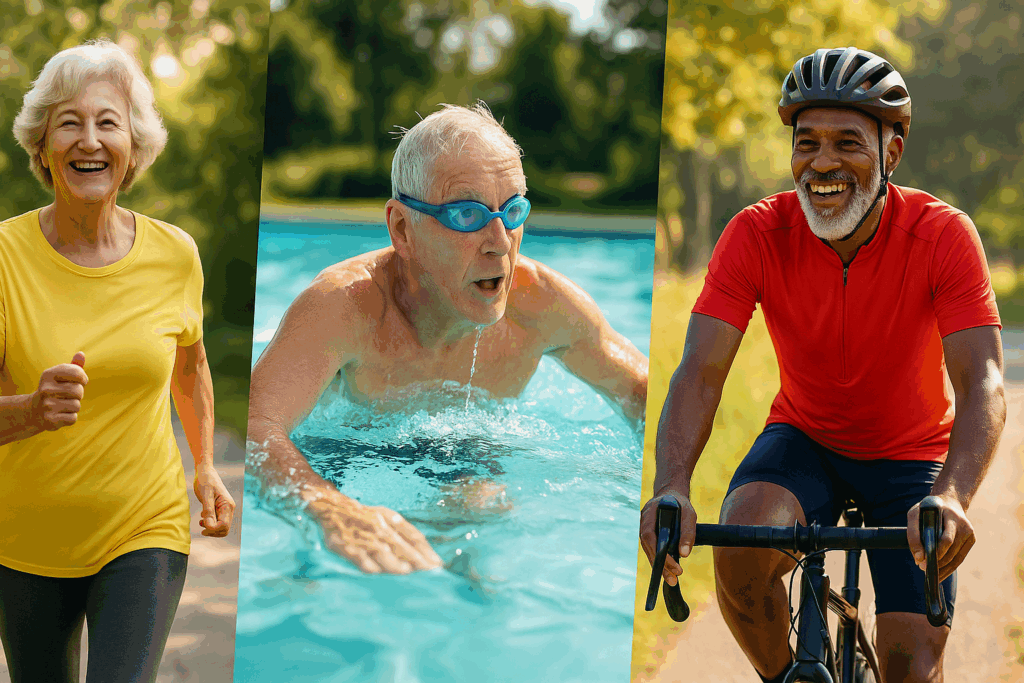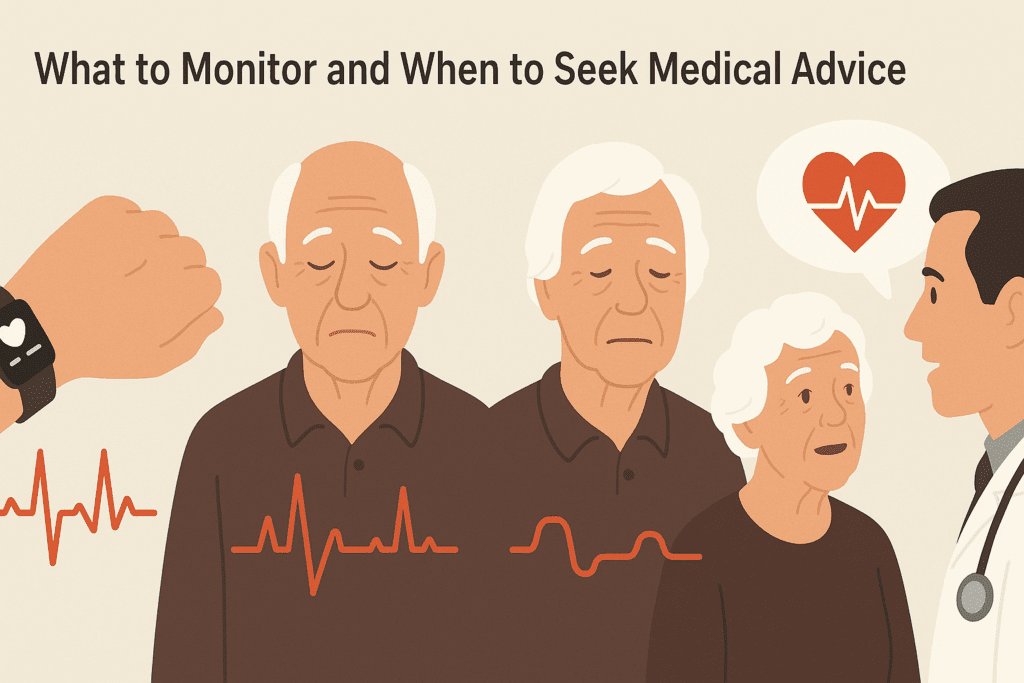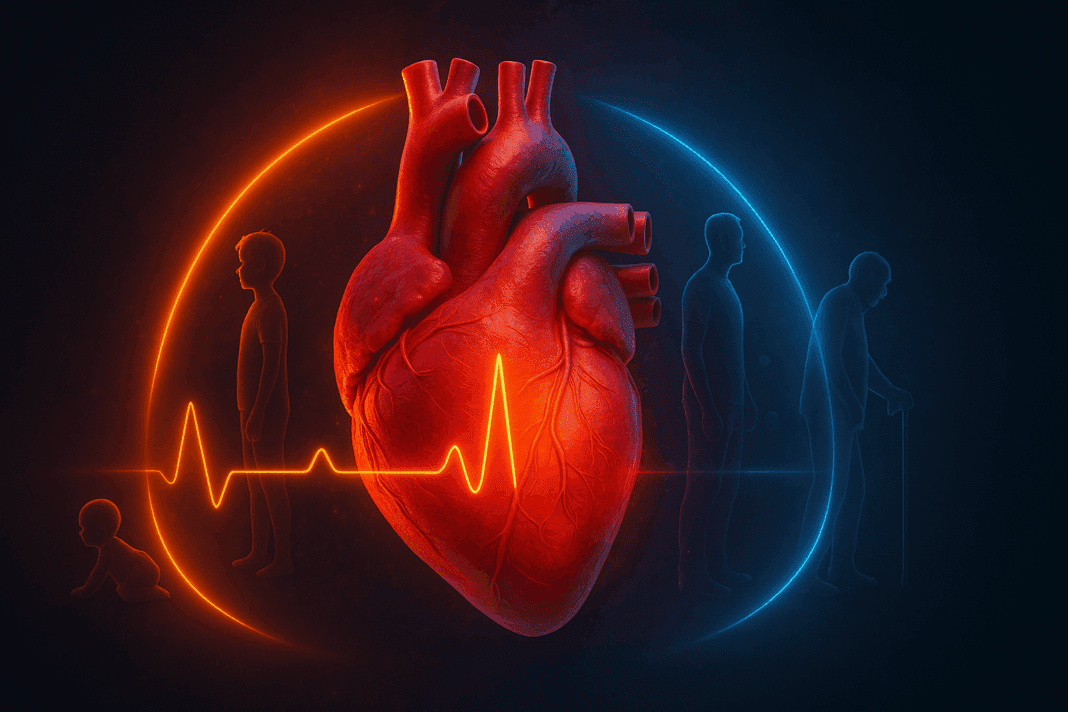Aging is an inevitable part of life, and with it comes a myriad of physiological changes that affect how our bodies function, including how our hearts perform. One of the most notable transformations occurs in the cardiovascular system. Among the commonly asked questions are: does aging cause faster heart rate, or does resting heart rate increase with age? These questions reflect a broader concern about heart rate in older adults and how it relates to endurance, stamina, and overall health. Understanding the nuances behind age-related heart changes is not only essential for maintaining optimal performance but also for mitigating risks associated with cardiovascular decline.
Throughout our lives, the heart is in a constant state of adaptation. As children, our resting heart rates tend to be higher, gradually slowing as we approach adulthood. But what happens as we continue to age? Does your heart grow with age, or does the heart weaken with age? And perhaps more curiously, when does your heart stop growing? These are not merely academic curiosities; they hold real-world implications for anyone concerned with athletic performance, cardiovascular longevity, or simply staying healthy in their senior years. This article explores how heart rate patterns evolve over time, the physiological changes of the aged heart, and what strategies individuals can use to maintain cardiovascular efficiency as they grow older.
You may also like: Smart Nutrition Choices for a Healthier Lifestyle: What to Know About Whole Grain Rice and Whole Wheat Rice

The Physiology of Heart Growth and Maturation
From birth through early adulthood, the human heart undergoes substantial development. As we grow, so does the size and strength of our heart. Typically, the heart stops growing in size once full physical maturity is reached, usually by the end of adolescence or early twenties. So when does your heart stop growing? While the structure remains largely stable after early adulthood, some functional aspects can still change with lifestyle, health conditions, and aging. In the absence of disease, the adult heart remains relatively constant in size, though minor enlargement may occur due to prolonged endurance training or pathological stress.
Interestingly, questions like “does your heart grow as you get older” stem from both scientific and anecdotal observations. For athletes or individuals who engage in consistent cardiovascular training, the heart can indeed adapt by increasing its efficiency and, to some degree, its size—a condition known as “athlete’s heart.” However, this is a functional adaptation rather than a true continuation of growth. In contrast, pathological enlargement—often linked to hypertension or heart failure—represents a maladaptive form of growth. These opposing forms of change highlight the importance of context when discussing whether the heart grows with age.
As age increases, the resting heart rate will often show changes, though not always in the direction people assume. Rather than becoming consistently faster or slower across all individuals, the pattern varies depending on fitness level, cardiovascular health, and the presence of chronic conditions. Still, a general trend toward reduced heart rate variability and a slightly higher resting rate may be observed in sedentary older adults, particularly when cardiovascular function is compromised. The aged heart, in other words, can behave differently depending on how it has been treated over the years.

Does Resting Heart Rate Increase or Decrease with Age?
One of the most commonly debated topics in cardiovascular health is whether resting heart rate increases or decreases with age. Some assume that as the body slows down, the heart must work harder, potentially leading to a faster pulse. But does aging cause faster heart rate in a meaningful way? The answer is nuanced. While the maximum heart rate tends to decline with age, the resting heart rate in older adults may stay the same, slightly increase, or even decrease depending on various factors.
So does resting heart rate increase with age? Statistically, there is a small upward trend in resting heart rate among sedentary individuals as they age, due largely to a decline in autonomic regulation and the reduced elasticity of blood vessels. However, in highly active older adults, resting heart rate often remains low, which is typically a sign of cardiovascular efficiency. This is why endurance athletes in their 60s can still exhibit resting heart rates similar to those of much younger people. Conversely, in some elderly individuals, the resting rate may decrease due to changes in the electrical conduction system of the heart, or because of medications such as beta blockers.
In light of these patterns, one might ask: does resting heart rate decrease with age or increase? The truth lies somewhere in between. There isn’t a one-size-fits-all answer. For example, changes in the sinoatrial node—the natural pacemaker of the heart—can lead to bradycardia, a slower-than-normal heartbeat, in some seniors. At the same time, age-related stress, poor sleep, or metabolic issues may contribute to an elevated resting pulse in others. Therefore, it’s important to assess heart rate trends in the context of individual health profiles rather than make broad generalizations.

Why Heart Rate Variability Changes Over Time
Heart rate variability (HRV), a measure of the variation between consecutive heartbeats, is another key indicator of cardiovascular health that changes with age. High HRV is generally associated with a robust autonomic nervous system and greater resilience to stress. Low HRV, on the other hand, can signify reduced adaptability and has been linked to a range of age-related diseases. As people get older, HRV tends to decline, even in the absence of overt heart disease.
This decline in variability is related to changes in both the sympathetic and parasympathetic branches of the nervous system. In particular, the aged heart becomes less responsive to vagal tone, which is responsible for the body’s ability to relax and slow the heart. This is one reason why some experts say that as age increases, the resting heart rate will exhibit reduced flexibility. It becomes more fixed in a narrower range and is slower to adapt to emotional or physical stressors. This physiological rigidity is a hallmark of cardiovascular aging and has implications for endurance and recovery.
The concept of heart rate in older adults is, therefore, deeply intertwined with HRV. Monitoring HRV can offer more detailed insights into the health of the aged heart than looking at resting heart rate alone. For athletes and performance-driven individuals, especially those entering middle or later life, HRV tracking can provide a powerful tool for assessing training readiness and recovery capacity. It allows for a more refined approach to fitness planning, tailored to the realities of an aging cardiovascular system.
Understanding Pulse and Heart Rate in the Elderly
When evaluating cardiovascular performance in older adults, it’s crucial to differentiate between resting heart rate, maximum heart rate, and pulse variability during activity. The term “pulse elderly” refers broadly to the typical pulse patterns observed in senior populations. On average, the pulse in elderly individuals tends to be slightly higher at rest compared to younger adults, but the maximum attainable heart rate during exertion declines. This discrepancy can affect endurance and stamina, making it more challenging for older adults to sustain high-intensity activity.
Why does heart rate decrease with age, particularly when it comes to maximum output? The primary reason lies in the reduced responsiveness of the sympathetic nervous system and diminished sensitivity of cardiac beta-adrenergic receptors. These changes lower the heart’s ability to speed up during exercise. The aged heart, while still capable of remarkable output in trained individuals, operates under a different set of physiological constraints compared to its younger counterpart.
Despite this, consistent aerobic exercise can mitigate many of these effects. Studies show that endurance training improves stroke volume and cardiac output even in older adults, helping maintain performance and delay functional decline. In other words, the aged heart is adaptable. It can be trained to work more efficiently, which in turn can lower resting heart rate and improve overall cardiovascular health. This is why a physically active 70-year-old might outperform a sedentary 40-year-old in cardiovascular metrics.

Does the Heart Weaken with Age?
Another central concern revolves around the question: does the heart weaken with age? From a structural perspective, certain age-related changes are inevitable. These may include thickening of the heart walls, stiffening of the arteries, and minor reductions in left ventricular function. However, these changes do not necessarily equate to a weakened heart unless they are compounded by disease or prolonged inactivity. Healthy aging, supported by good nutrition, regular exercise, and stress management, can preserve much of the heart’s function well into older age.
It’s important to distinguish between age-related decline and pathological deterioration. The aged heart may experience changes in collagen deposition, which affects the elasticity of cardiac tissue. Still, this doesn’t mean the heart cannot perform well. In fact, research indicates that older adults who engage in consistent cardiovascular training often retain a high level of performance and cardiac resilience. These individuals show that while aging influences heart performance, it doesn’t determine it outright.
Furthermore, lifestyle interventions can significantly influence whether or not the heart weakens with age. For instance, a Mediterranean diet rich in omega-3 fatty acids, coupled with stress-reducing practices like yoga or meditation, has been shown to improve endothelial function and reduce arterial stiffness. These changes translate directly into better heart rate regulation and improved pulse control, particularly important when considering how does heart rate increase with age during stress or illness.

How Age Influences Exercise, Endurance, and Cardiovascular Performance
As people age, their ability to perform endurance activities changes, not just because of muscle loss or joint stiffness, but due to alterations in cardiovascular dynamics. One major adjustment is in the body’s ability to circulate blood efficiently, particularly during peak exertion. This is partly because as age increases, the resting heart rate will often rise slightly, reflecting the body’s diminished cardiovascular reserve. That said, these effects are far less pronounced in physically fit older adults, highlighting the importance of regular training.
Does heart rate increase with age during exercise, or is the response blunted? In truth, the peak heart rate decreases with age, meaning the heart does not reach the same speeds it could during youth. However, for most healthy individuals, the resting pulse remains an excellent predictor of overall cardiovascular fitness. Those with lower resting heart rates typically demonstrate better endurance and recovery profiles. When heart rate in older adults remains within an optimal range, it suggests that cardiovascular health is well-preserved.
From a performance enhancement perspective, understanding how heart rate shifts with age enables athletes and active individuals to recalibrate their training goals. Rather than pushing for high maximum heart rates, older adults may benefit more from moderate-intensity, steady-state cardio that enhances stroke volume and oxygen delivery without overstraining the aged heart. Strategic use of heart rate zones can make endurance training more effective and safer for those over 50.

Practical Ways to Support a Healthy Heart Rate as You Age
Maintaining a healthy heart rate throughout the aging process requires a multifaceted approach. First and foremost, regular aerobic exercise has been proven to reduce resting heart rate, improve heart rate variability, and enhance overall cardiac output. Activities like brisk walking, swimming, and cycling are particularly effective for older adults, as they provide cardiovascular benefits without excessive joint stress. Additionally, strength training has emerged as a vital complement to cardio, helping preserve lean muscle mass and metabolic function.
Nutrition also plays a significant role. Diets high in fruits, vegetables, lean proteins, and healthy fats support vascular health and autonomic regulation. Foods rich in potassium and magnesium help regulate pulse and prevent arrhythmias. Hydration is equally important, as dehydration can elevate resting heart rate and lead to cardiovascular strain. Older adults are especially vulnerable to fluid imbalances, making this an essential part of heart rate management.
Stress management is another overlooked but critical element. Chronic stress triggers sustained sympathetic activation, which can lead to persistently elevated heart rate and reduced HRV. Incorporating relaxation techniques such as mindfulness meditation, deep breathing exercises, or even tai chi can reduce stress hormones and support parasympathetic dominance—key for lowering resting pulse in elderly individuals and protecting the aged heart from overexertion.

What to Monitor and When to Seek Medical Advice
While age-related changes in heart rate are normal, it’s important to recognize when fluctuations may indicate an underlying issue. Persistent tachycardia (elevated heart rate), especially at rest, may point to thyroid dysfunction, dehydration, or cardiovascular disease. Likewise, an unusually low resting heart rate in seniors—particularly if accompanied by fatigue or dizziness—may signal bradycardia or conduction system abnormalities. In both cases, a healthcare provider should be consulted.
Wearable fitness trackers and heart rate monitors offer accessible ways for individuals to observe changes in heart rate over time. These tools can help identify trends, such as whether resting heart rate increases or decreases with age in a given individual. They can also flag irregular rhythms or excessive variability, prompting early medical intervention. Understanding the dynamics of heart rate in older adults enables a more proactive approach to long-term cardiovascular care.
Frequently Asked Questions: How Heart Rate Changes with Age
1. Can stress and emotional health affect whether resting heart rate increases or decreases with age? Yes, chronic stress plays a substantial role in determining whether resting heart rate increases with age. Emotional strain activates the sympathetic nervous system, which can elevate heart rate and reduce heart rate variability over time. For older adults, this prolonged sympathetic dominance may compound the age-related decline in vagal tone, contributing to higher resting pulse levels. In some cases, the stress response may mask the underlying question of “does resting heart rate increase with age,” as it may appear elevated due to psychological rather than physiological aging factors. Incorporating mindfulness, therapy, and relaxation techniques can help regulate the heart rate in older adults and reduce long-term cardiovascular risk.
2. What is the relationship between sleep quality and heart rate in older adults? Sleep quality directly influences heart rate, particularly during resting periods. Poor sleep, which becomes more common with age, can cause intermittent elevations in heart rate due to frequent nighttime awakenings or sleep apnea. These disruptions make it harder for the aged heart to recover during the night, potentially leading to increased resting pulse in elderly individuals. While it may not fully answer the question of “does aging cause faster heart rate,” poor sleep can simulate similar patterns and should be considered in cardiovascular assessments. Addressing sleep hygiene and evaluating for conditions like insomnia or sleep apnea can meaningfully improve resting heart rate in older adults.
3. Is it possible for heart rate to become less responsive to physical activity as we age? Absolutely. One of the hallmarks of the aged heart is a reduced responsiveness to exercise stimuli. This doesn’t necessarily mean resting heart rate decreases with age, but it does suggest that maximum heart rate during exertion declines. The ability to elevate heart rate efficiently becomes impaired due to less responsive beta-adrenergic receptors. This may create the illusion that does heart rate decrease with age is a uniform truth, when in reality, it’s often the heart’s performance range that narrows. Individuals can combat this decline by engaging in regular cardiovascular training tailored to their age and physical condition.
4. Are there any medications that may alter heart rate trends as people age? Yes, medications can significantly influence the observed patterns of heart rate in older adults. Beta blockers, often prescribed for hypertension or arrhythmias, can lower resting heart rate and complicate the analysis of whether resting heart rate decreases with age due to natural factors. Other medications, such as thyroid hormone replacements or stimulants, can have the opposite effect and elevate resting pulse. It’s important to distinguish whether changes are a side effect or a true reflection of aging. Regular consultations with a physician can help ensure that your pulse in elderly years reflects your health status, not just your prescriptions.
5. How do hormonal changes affect heart rate as we age, particularly in women? Hormonal shifts, especially during menopause, can significantly influence heart rate dynamics. Estrogen has a cardioprotective effect, promoting vascular flexibility and supporting parasympathetic tone. As estrogen levels decline, some women may experience palpitations or elevated resting pulse, prompting questions about whether heart rate increases with age. However, this increase may be more transient and hormone-driven than age-driven. Understanding this distinction can help women make informed decisions about lifestyle adjustments and hormone replacement therapy to support heart rate in older adults.
6. When does your heart stop growing, and does it ever grow again under certain conditions? Typically, the heart reaches its adult size by the end of adolescence or early adulthood, so in most cases, the answer to when does your heart stop growing is sometime between ages 18 and 25. However, the heart can undergo secondary growth through a process called hypertrophy. This can be a healthy adaptation, such as in endurance athletes, or pathological, as seen in hypertension. Therefore, while the general question “does your heart grow with age” would usually warrant a “no,” exceptions arise based on activity levels and health conditions. Regular cardiovascular assessments can help determine whether such growth is functional or concerning.
7. How does cardiovascular fitness impact the typical pulse elderly individuals experience? Fitness plays a crucial role in shaping the resting and active pulse in elderly populations. Older adults who maintain high levels of aerobic fitness tend to have lower resting heart rates and higher heart rate variability. This improved efficiency can sometimes challenge assumptions about whether resting heart rate increases with age or if aging causes faster heart rate trends. In well-trained individuals, the aged heart adapts more effectively and may resemble the cardiac profile of a much younger person. This underlines the importance of lifelong fitness habits for mitigating age-related cardiovascular decline.
8. What diagnostic tools can help track heart rate changes related to aging? Beyond traditional heart rate monitoring, tools such as wearable ECG monitors, heart rate variability trackers, and stress response tests can offer a more complete view of cardiovascular aging. These technologies can reveal patterns that answer whether resting heart rate increases or decreases with age in a more individualized manner. They can also highlight potential irregularities that may not present as overt symptoms. For the aged heart, early detection of abnormal trends can prevent more serious conditions. Understanding subtle changes can inform both medical and lifestyle interventions for heart rate in older adults.
9. Why does heart rate decrease with age in some individuals but increase in others? The direction of heart rate change with age depends on multiple interacting factors, including genetics, lifestyle, comorbidities, and medication use. For some, improved parasympathetic tone through fitness or genetic predisposition may explain why resting heart rate decreases with age. For others, chronic conditions like anemia, diabetes, or hormonal imbalances may lead to an increase, supporting the view that does aging cause faster heart rate under certain conditions. Rather than a single rule, it’s best to view these changes as part of a spectrum influenced by personal health history. A personalized approach to aging and cardiovascular care is essential.
10. How can psychological resilience influence whether the heart weakens with age? Psychological resilience—our capacity to adapt to stress and adversity—can significantly impact whether or not the heart weakens with age. People who maintain positive outlooks and proactive coping strategies tend to experience lower baseline heart rates and better cardiovascular outcomes. This suggests that does the heart weaken with age is not a foregone conclusion but can be influenced by mental habits and stress perception. Long-term studies have shown that optimism and emotional stability correlate with healthier pulse rates in elderly populations. These findings reinforce the mind-heart connection and the importance of holistic wellness strategies as age increases and the resting heart rate will reflect both mental and physical well-being.
Conclusion: Embracing Cardiovascular Awareness for Lifelong Performance
As we navigate the journey of aging, the heart remains both a barometer and a beacon of our overall health. Understanding how heart rate changes with age empowers individuals to make informed decisions that enhance not only longevity but also quality of life. Whether you’re wondering does aging cause faster heart rate, or exploring why does heart rate decrease with age, the answers lie in a personalized understanding of cardiovascular dynamics, rooted in science and shaped by lifestyle.
The aged heart is not a symbol of decline, but rather of adaptation. With proper care, attention to fitness, nutrition, and stress, it’s possible to maintain a steady and efficient resting pulse well into later years. Whether heart rate increases or decreases with age depends largely on how we live, not just how many birthdays we’ve celebrated. As age increases, the resting heart rate will tell a story—and with the right strategy, it can be a story of strength, endurance, and lasting vitality.
Was this article helpful? Don’t let it stop with you. Share it right now with someone who needs to see it—whether it’s a friend, a colleague, or your whole network. And if staying ahead on this topic matters to you, subscribe to this publication for the most up-to-date information. You’ll get the latest insights delivered straight to you—no searching, no missing out.
Further Reading:
Aging changes in the heart and blood vessels
Aging-associated cardiovascular changes and their relationship to heart failure

